-
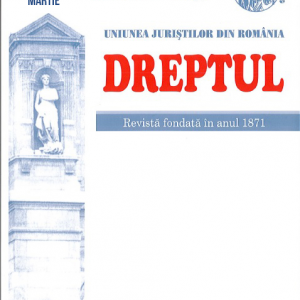 The authors comment on the provisions of art. 1013 to 1024 of the new Romanian Code of Civil Procedure (Law no. 134/2010 of the Code of Civil Procedure, republished in the “Official Gazette of Romania”, Part I, no. 545 of 3 August 2012 and entered into force on 15 February 2013) on the instruction payment special procedure, whereby the legislator establishes uniform rules for combating the late payment of certain amounts of money, bringing together the provisions previously established by the two laws, currently repealed (Government Ordinance no. 5/2001 and Government Emergency Ordinance no. 119/2007). When stating the conclusions of the study, the authors welcome the legislative solution and point out that the payment instruction procedure can be used concurrently with the small claims procedure (art. 1025 to 1032 Civil Procedure Code), as these two special procedures do not exclude each other.
The authors comment on the provisions of art. 1013 to 1024 of the new Romanian Code of Civil Procedure (Law no. 134/2010 of the Code of Civil Procedure, republished in the “Official Gazette of Romania”, Part I, no. 545 of 3 August 2012 and entered into force on 15 February 2013) on the instruction payment special procedure, whereby the legislator establishes uniform rules for combating the late payment of certain amounts of money, bringing together the provisions previously established by the two laws, currently repealed (Government Ordinance no. 5/2001 and Government Emergency Ordinance no. 119/2007). When stating the conclusions of the study, the authors welcome the legislative solution and point out that the payment instruction procedure can be used concurrently with the small claims procedure (art. 1025 to 1032 Civil Procedure Code), as these two special procedures do not exclude each other. -
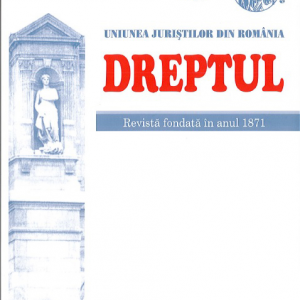 In this article the author analyzes the procedure of individual complaint of the citizens before the Federal Constitutional Court of Germany as it is regulated in the Federal Constitution and in the special law on the constitutional control court. The constitutional text provides that the procedure in question is a legal means of appeal with the purpose of defending human rights and fundamental freedoms. Specifically, any person who claims that one of his rights or one of his freedoms enshrined in the Basic Law has been violated by an authority exercising public power may address the federal constitutional court. The author analyzes the procedure of individual complaint and separates it from other constitutional procedures.
In this article the author analyzes the procedure of individual complaint of the citizens before the Federal Constitutional Court of Germany as it is regulated in the Federal Constitution and in the special law on the constitutional control court. The constitutional text provides that the procedure in question is a legal means of appeal with the purpose of defending human rights and fundamental freedoms. Specifically, any person who claims that one of his rights or one of his freedoms enshrined in the Basic Law has been violated by an authority exercising public power may address the federal constitutional court. The author analyzes the procedure of individual complaint and separates it from other constitutional procedures. -
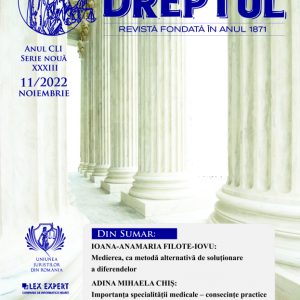 Declaration of the unconstitutionality of the Article 164 (1) Civil Code provisions has determined the adoption, with an unjustified delay, of the Law No 140/2022 on some protection measures for people with intellectual and psychosocial disabilities and the modification and completion of some normative acts, which establish assistance for the conclusion of legal acts, judicial counseling and special guardianship, as well as a clear and flexible procedure for the establishment of these protection measures. Every person must be free to act in order to develop his/her personality, the state, by virtue of its social character, having the obligation to regulate a normative framework to ensure respect for the individual, the full expression of the personality of citizens, of their rights and freedoms, of the equal opportunities, resulting in respect for human dignity.
Declaration of the unconstitutionality of the Article 164 (1) Civil Code provisions has determined the adoption, with an unjustified delay, of the Law No 140/2022 on some protection measures for people with intellectual and psychosocial disabilities and the modification and completion of some normative acts, which establish assistance for the conclusion of legal acts, judicial counseling and special guardianship, as well as a clear and flexible procedure for the establishment of these protection measures. Every person must be free to act in order to develop his/her personality, the state, by virtue of its social character, having the obligation to regulate a normative framework to ensure respect for the individual, the full expression of the personality of citizens, of their rights and freedoms, of the equal opportunities, resulting in respect for human dignity. -
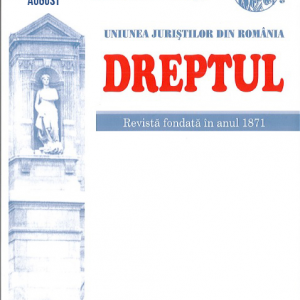 The article analyzes the regulation of trial when admitting guilt and the practical consequences resulting from this procedure. Admission of guilt can be made either by statement of the defendant in court, or under writ, in which case the proceedings may take place without the presence of the defendant. In terms of object of admission, out of the marginal terms of wording under Article 3201 Code of Criminal Procedure Code, it appears that it refers to “guilt”, but from the reading of paragraph (1) of the said wording it appears that admission refers to “committing acts written down in the document instituting the proceedings”. Should we relate this regulatory text to the provisions of Article 263 par. (1) Code of Criminal Procedure, regulating the indictment contents, it is clear that admission is limited to committing the crime exclusively, failing to refer to the legal classification granted under the document instituting the proceedings or any other person to which it relates. Article 3201 in the Code of Criminal Procedure is, as evidenced by the mere reading of its wording, of its marginal name and the topography of the Code of Criminal Procedure, undeniably, a procedural rule designed to accelerate the settlement process and not a rule of substantive criminal law. Bearing this legal nature, the authors argue that Article 3201 Code of Criminal Procedure can not be considered a more favourable criminal law (mitior lex), its provisions falling outside Articles 13-15 Criminal Code.
The article analyzes the regulation of trial when admitting guilt and the practical consequences resulting from this procedure. Admission of guilt can be made either by statement of the defendant in court, or under writ, in which case the proceedings may take place without the presence of the defendant. In terms of object of admission, out of the marginal terms of wording under Article 3201 Code of Criminal Procedure Code, it appears that it refers to “guilt”, but from the reading of paragraph (1) of the said wording it appears that admission refers to “committing acts written down in the document instituting the proceedings”. Should we relate this regulatory text to the provisions of Article 263 par. (1) Code of Criminal Procedure, regulating the indictment contents, it is clear that admission is limited to committing the crime exclusively, failing to refer to the legal classification granted under the document instituting the proceedings or any other person to which it relates. Article 3201 in the Code of Criminal Procedure is, as evidenced by the mere reading of its wording, of its marginal name and the topography of the Code of Criminal Procedure, undeniably, a procedural rule designed to accelerate the settlement process and not a rule of substantive criminal law. Bearing this legal nature, the authors argue that Article 3201 Code of Criminal Procedure can not be considered a more favourable criminal law (mitior lex), its provisions falling outside Articles 13-15 Criminal Code. -
 The present paper aims to examine the „positive” conditions of the procedure of the right to damage repair in case of miscarriage of justice, i.e. those provided only in paragraph (1) of Article 538 of the Criminal Procedure Code. The paper begins with the delimitation of the area of analysis, after which it examines the conceptual reason of the analyzed procedure. Then, the conditions and subconditions found in paragraph (1) of Article 538 of the Criminal Procedure Code are treated by turns. Finally, after analyzing the concept of miscarriage of justice, we take a look at countries with similar legislation: the Republic of Moldova and Switzerland. At the same time, through this material, I am trying to demonstrate, by identifying the problems of interpretation of this paragraph, the fact that the action for damage repair provided in Chapter VI of the Criminal Procedure Code must comply, at least in the light of paragraph (1) of Article 538 far too restrictive conditions. The conditions which this paragraph involves turn the procedure of repair of the material damage or of the moral damage in case of miscarriage of justice into a non-feasible procedure with conditions which presuppose an insignificant stake, as compared to the reparation of the damage in case of the principal’s liability for the deed of his agent, a liability much easier to prove by the damaged person.
The present paper aims to examine the „positive” conditions of the procedure of the right to damage repair in case of miscarriage of justice, i.e. those provided only in paragraph (1) of Article 538 of the Criminal Procedure Code. The paper begins with the delimitation of the area of analysis, after which it examines the conceptual reason of the analyzed procedure. Then, the conditions and subconditions found in paragraph (1) of Article 538 of the Criminal Procedure Code are treated by turns. Finally, after analyzing the concept of miscarriage of justice, we take a look at countries with similar legislation: the Republic of Moldova and Switzerland. At the same time, through this material, I am trying to demonstrate, by identifying the problems of interpretation of this paragraph, the fact that the action for damage repair provided in Chapter VI of the Criminal Procedure Code must comply, at least in the light of paragraph (1) of Article 538 far too restrictive conditions. The conditions which this paragraph involves turn the procedure of repair of the material damage or of the moral damage in case of miscarriage of justice into a non-feasible procedure with conditions which presuppose an insignificant stake, as compared to the reparation of the damage in case of the principal’s liability for the deed of his agent, a liability much easier to prove by the damaged person. -
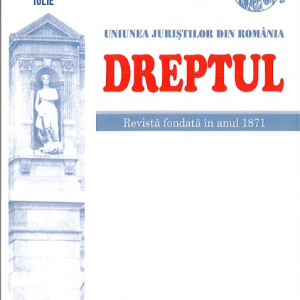 Special procedures are rules derogatory from the common rules governing the criminal trial. They are also of a supplemental type and strict enforcement when a certain procedural aspect is regulated differently than the common rules. However, their purpose is the same, namely the resolution of the criminal and civil action, when required. Among these procedures, the agreement for acknowledgement of guilt is a transaction concluded between the prosecutor, as a representative of the state, and the defendant. The agreement for acknowledgement of guilt must meet certain requirements of substance and form. The court solutions in case of examining the agreement for acknowledgement of guilt can be of accepting the agreement for acknowledgement of guilt and admitting the factual basis of the offence for which the defendant acknowledges his/her guilt and of not accepting the agreement for acknowledgement of guilt. In the first situation, the judgment can be appealed only for procedural errors and the amount of punishment and, in the second situation, the prosecutor may file and appeal within 24 hours or, if not, the court orders the judgment of the case according to the usual procedure.
Special procedures are rules derogatory from the common rules governing the criminal trial. They are also of a supplemental type and strict enforcement when a certain procedural aspect is regulated differently than the common rules. However, their purpose is the same, namely the resolution of the criminal and civil action, when required. Among these procedures, the agreement for acknowledgement of guilt is a transaction concluded between the prosecutor, as a representative of the state, and the defendant. The agreement for acknowledgement of guilt must meet certain requirements of substance and form. The court solutions in case of examining the agreement for acknowledgement of guilt can be of accepting the agreement for acknowledgement of guilt and admitting the factual basis of the offence for which the defendant acknowledges his/her guilt and of not accepting the agreement for acknowledgement of guilt. In the first situation, the judgment can be appealed only for procedural errors and the amount of punishment and, in the second situation, the prosecutor may file and appeal within 24 hours or, if not, the court orders the judgment of the case according to the usual procedure. -
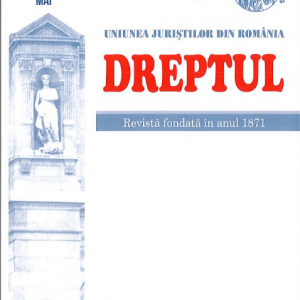 Relatively recently brought under regulation by our law system, the models of utility are inventions with a lower level of complexity that are legally protected by means of the protection certificate released following a specific procedure. Encompassed in the study presented herein are precisely those judicial aspects of the formalities that need to be fulfilled when aiming at the release of the model of utility certificate of protection. Altogether, the author sets forth an original point of view regarding the approach and the systematisation of the internal and international formalities to be taken into account when dealing with the procedure of releasing the protection title for the models of utility, and also critically inspects the legal editing process, and the corelation between some legal provisions belonging to this field of interest and intereferring law-related notions, while laying down relevant de lege ferenda proposals in fulfilling the purpose of correction and defining with more clarity the legal provisions specific to this law branch.
Relatively recently brought under regulation by our law system, the models of utility are inventions with a lower level of complexity that are legally protected by means of the protection certificate released following a specific procedure. Encompassed in the study presented herein are precisely those judicial aspects of the formalities that need to be fulfilled when aiming at the release of the model of utility certificate of protection. Altogether, the author sets forth an original point of view regarding the approach and the systematisation of the internal and international formalities to be taken into account when dealing with the procedure of releasing the protection title for the models of utility, and also critically inspects the legal editing process, and the corelation between some legal provisions belonging to this field of interest and intereferring law-related notions, while laying down relevant de lege ferenda proposals in fulfilling the purpose of correction and defining with more clarity the legal provisions specific to this law branch. -
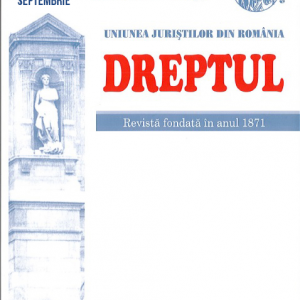 In this study, the author examines exhaustively the problems of the preliminary proceedings before the Court of Justice of the European Union [Article 19 (3) (b) of the Treaty on European Union; Article 267 of the Treaty on the Functioning of the European Union]. To this end there are examined: the referral, the preliminary, the preliminary procedure of common law and the special prejudicial procedures.
In this study, the author examines exhaustively the problems of the preliminary proceedings before the Court of Justice of the European Union [Article 19 (3) (b) of the Treaty on European Union; Article 267 of the Treaty on the Functioning of the European Union]. To this end there are examined: the referral, the preliminary, the preliminary procedure of common law and the special prejudicial procedures. -
 In this study, the author presents, from the point of view of the constitutional law, the complex process of re-emergence of the state formations after the break-up of the Roman imperial administration at the end of the 5th century. The collapse of the boundaries of the West Roman Empire and the penetration of the conquering migratory populations to its centre have generated not only the destruction of the military capacity of the empire and its army, but also of the political institutions and of the entire Roman administration. Practically, the Roman state has entered an advanced dissolution process that has led also to the replacement of the old production relations with new relations. Instead of the Roman administration, rudimentarily organized patriarchal formations which responded to the new military conditions imposed on the indigenous population by the conquering populations appeared. At the same time with these, in the former Roman provinces, the Christian churches continued to carry on a social organization activity. Practically, the Christian Church took over some social organization and management functions, specific in the past to the Roman administration. The gradual conversion of the conquering populations to Christianity has stimulated the process of restating and the emergence of the first barbarian kingdoms. The Church had thus an overwhelming role and hastened the re-emergence of the statehood on the former territories of the vast Roman Empire. Finally, new states have emerged on the European continent, with well defined ethnic physiognomies and endowed with a political administration based on constitutional principles that have proven their validity in the subsequent centuries. At the same time with the formation of the new states, a new theory of the political institutions has been forged and gradually developed, in which, along with the elements of laic thinking, many precepts of Christian religion can be emphasized.
In this study, the author presents, from the point of view of the constitutional law, the complex process of re-emergence of the state formations after the break-up of the Roman imperial administration at the end of the 5th century. The collapse of the boundaries of the West Roman Empire and the penetration of the conquering migratory populations to its centre have generated not only the destruction of the military capacity of the empire and its army, but also of the political institutions and of the entire Roman administration. Practically, the Roman state has entered an advanced dissolution process that has led also to the replacement of the old production relations with new relations. Instead of the Roman administration, rudimentarily organized patriarchal formations which responded to the new military conditions imposed on the indigenous population by the conquering populations appeared. At the same time with these, in the former Roman provinces, the Christian churches continued to carry on a social organization activity. Practically, the Christian Church took over some social organization and management functions, specific in the past to the Roman administration. The gradual conversion of the conquering populations to Christianity has stimulated the process of restating and the emergence of the first barbarian kingdoms. The Church had thus an overwhelming role and hastened the re-emergence of the statehood on the former territories of the vast Roman Empire. Finally, new states have emerged on the European continent, with well defined ethnic physiognomies and endowed with a political administration based on constitutional principles that have proven their validity in the subsequent centuries. At the same time with the formation of the new states, a new theory of the political institutions has been forged and gradually developed, in which, along with the elements of laic thinking, many precepts of Christian religion can be emphasized. -
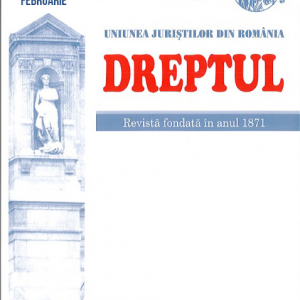 In the following study the author reviews the decision making in the European Union (including the European Atomic Energy Community) as governed by the Treaty on European Union and the Treaty on the Functioning of the European Union subsequent to the entry into force of the Lisbon Treaty (which occurred on December 1st, 2009), compared with previous regulations, the exposure being focused on the innovations brought by the latter Treaty, in relation to previous establishments.
In the following study the author reviews the decision making in the European Union (including the European Atomic Energy Community) as governed by the Treaty on European Union and the Treaty on the Functioning of the European Union subsequent to the entry into force of the Lisbon Treaty (which occurred on December 1st, 2009), compared with previous regulations, the exposure being focused on the innovations brought by the latter Treaty, in relation to previous establishments. -
 Procesul lui Iisus, poate cel mai cunoscut proces din istoria umanității, este și cea mai vădită eroare judiciară a tuturor timpurilor. „Prototipul însuși al condamnatului nevinovat”1 generează din această perspectivă o temă de analiză aprofundată și dezbatere atât pentru teologi, istorici sau analiști ai fenomenului religios, cât și pentru juriștii preocupați de identificarea greșelilor procedurale săvârșite pe parcursul celebrului proces. Format și educat într-o familie cu profunde valori creștine, imaginea răstignirii lui Iisus m-a marcat, m-a impresionat și mi-a stârnit nenumărate emoții și motive de meditații. Cu toate acestea, până la întâlnirea cu lumea dreptului, nu m-am gândit că întregul proces de condamnare a celui mai cunoscut nevinovat al istoriei poate fi analizat și din perspectiva juridică. Din aceste considerente, prezentul editorial își propune să abordeze procesul lui Iisus, prezentând elemente și date ce descriu locul și data desfășurării, personajele implicate și resursele biblice sau extrabiblice utilizate
Procesul lui Iisus, poate cel mai cunoscut proces din istoria umanității, este și cea mai vădită eroare judiciară a tuturor timpurilor. „Prototipul însuși al condamnatului nevinovat”1 generează din această perspectivă o temă de analiză aprofundată și dezbatere atât pentru teologi, istorici sau analiști ai fenomenului religios, cât și pentru juriștii preocupați de identificarea greșelilor procedurale săvârșite pe parcursul celebrului proces. Format și educat într-o familie cu profunde valori creștine, imaginea răstignirii lui Iisus m-a marcat, m-a impresionat și mi-a stârnit nenumărate emoții și motive de meditații. Cu toate acestea, până la întâlnirea cu lumea dreptului, nu m-am gândit că întregul proces de condamnare a celui mai cunoscut nevinovat al istoriei poate fi analizat și din perspectiva juridică. Din aceste considerente, prezentul editorial își propune să abordeze procesul lui Iisus, prezentând elemente și date ce descriu locul și data desfășurării, personajele implicate și resursele biblice sau extrabiblice utilizate -
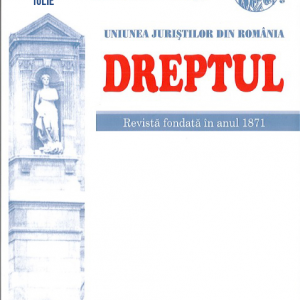 The criminal trial can be defined as the activity regulated by law, carried out by the criminal judicial bodies, so that persons having committed criminal offenses are brought to account for criminal liability and criminal penalties are imposed. Criminal trial aims to account for criminal liability persons who have committed criminal offences (i.e. achievement of the conflict criminal legal relationship), imposition of criminal penalties and their enforcement. The criminal trial phase is a division thereof, in which operate a particular category of judicial bodies in carrying out tasks that fall within their procedural position (to seek, to judge or to execute the decision), and following its exhaustion a particular solution on the criminal case may be rendered. The author reveals that, under the current Romanian legislation, the criminal trial covers three phases: prosecution, adjudication and enforcement of judgments (according to the Romanian doctrine, although the Code of Criminal Procedure in force entitles „Enforcement of Criminal Judgments” Title III of the Special Part). Under the new Code of criminal procedure rules, the criminal trial covers four phases: prosecution, the preliminary chamber, adjudication and enforcement of criminal judgments.
The criminal trial can be defined as the activity regulated by law, carried out by the criminal judicial bodies, so that persons having committed criminal offenses are brought to account for criminal liability and criminal penalties are imposed. Criminal trial aims to account for criminal liability persons who have committed criminal offences (i.e. achievement of the conflict criminal legal relationship), imposition of criminal penalties and their enforcement. The criminal trial phase is a division thereof, in which operate a particular category of judicial bodies in carrying out tasks that fall within their procedural position (to seek, to judge or to execute the decision), and following its exhaustion a particular solution on the criminal case may be rendered. The author reveals that, under the current Romanian legislation, the criminal trial covers three phases: prosecution, adjudication and enforcement of judgments (according to the Romanian doctrine, although the Code of Criminal Procedure in force entitles „Enforcement of Criminal Judgments” Title III of the Special Part). Under the new Code of criminal procedure rules, the criminal trial covers four phases: prosecution, the preliminary chamber, adjudication and enforcement of criminal judgments.
